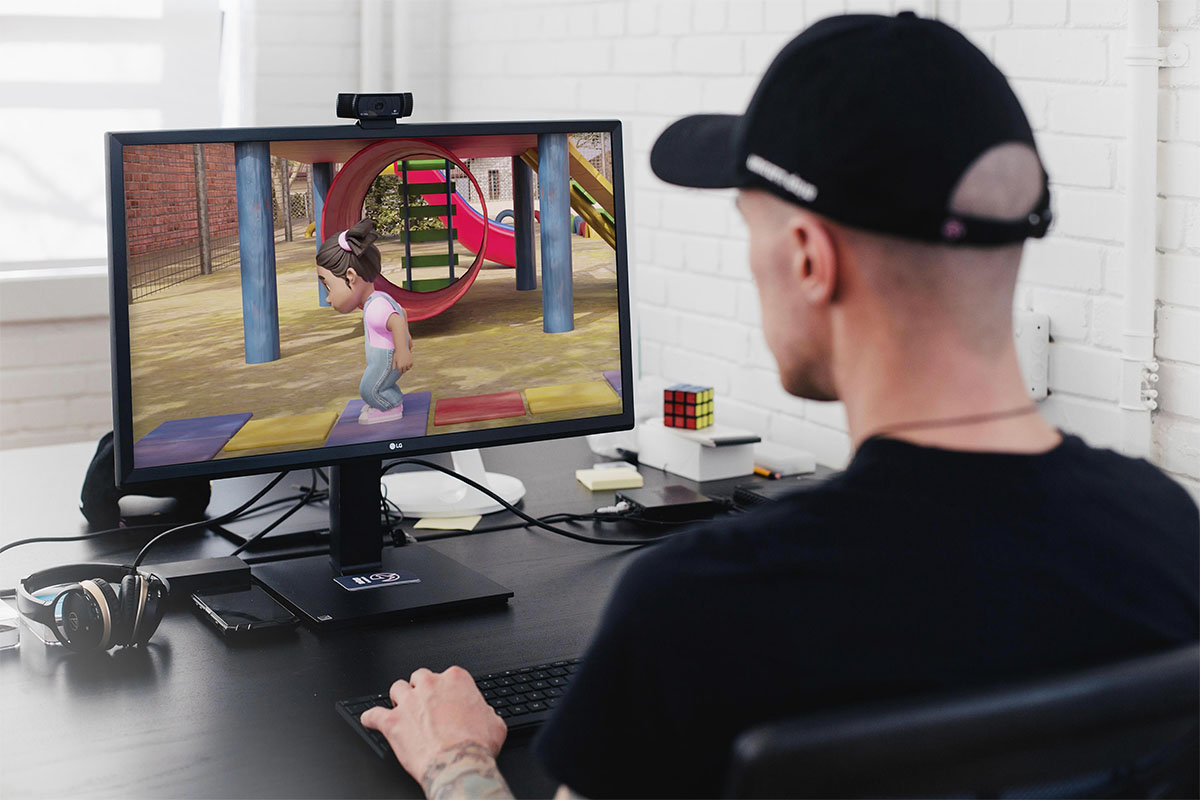
Animation Studios in South Africa: Squash and Stretch
It might sound like something you would do in a fitness class, but “Squash and Stretch” is actually one of the most important principles in animation. You know, the kind of technique that takes a simple bounce, like that of a ball, and turns it into something that feels truly alive. Whether you are watching a corporate explainer video or a marketing animation, this deceptively simple principle is at work, adding just the right amount of movement to make your content feel natural and engaging. While this principle is often associated with cartoons, it is essential to every type of animation — and it is something that skilled animation studios in South Africa understand well.
But let’s not get ahead of ourselves. Squash and Stretch is not just a trick for making characters look squishy or bouncy. It is an essential tool that helps animation feel more grounded in reality, even if you are dealing with abstract shapes, logos, or data visuals. In this article, we will unpack why this principle is so important, how it is used in different types of B2B animation, and why getting it right is more challenging (and important) than you might think.
What Is Squash and Stretch?
Squash and Stretch is as simple as it sounds: it is when an object deforms, either squashing down or stretching out, as it moves. The goal here is to show the effect of forces acting on an object. For example, when a ball hits the ground, it squashes as the impact happens, and then stretches back as it bounces upward. However, even though the object deforms, it still maintains its volume — it does not lose any mass.
This is where the fun begins. Squash and Stretch is not just about making things look elastic and cartoony. It is about making objects behave like they are meant to. In 3D animation, 2D characters, or even motion graphics, this principle can be applied subtly to help movements feel more natural, and yes — more lively.
When done correctly, Squash and Stretch can help make even the simplest object feel more expressive and impactful. Whether you are looking at a tool icon in a training video, a logo animation, or a character reacting to something in a marketing ad, the principle of Squash and Stretch is at the heart of making these animations feel grounded, yet dynamic.
Why It Matters in B2B Animation
You might assume that Squash and Stretch is a technique reserved for animation in entertainment, rather than for professional business applications. But bear with me — Squash and Stretch is far more than just a way to make things bounce. In fact, it is integral to B2B animation for several reasons:
- Keeping Things Lively: Imagine watching an animation where every movement is stiff and mechanical. It is not exactly convincing, is it? Squash and Stretch adds movement and fluidity to animation, making it more engaging. Whether you are creating a corporate explainer video or an animated infographic, a little bounce here and there keeps things visually interesting. For businesses creating training materials or marketing content, animation studios in South Africa know how to use this technique to keep the content from feeling flat.
- Detail and Nuance: Squash and Stretch is not always about exaggerated movements. In fact, when applied subtly, it can convey a lot of information. It can show the weight of an object, the force behind an action, and even the emotional state of a character. Imagine a character in a corporate explainer video reacting to an idea — their body might slightly stretch upward as they get excited. These little touches make all the difference, and animation studios in South Africa know how to use this technique effectively without it overwhelming the rest of the animation.
- Clarifying Emotional Reactions: One of the more understated benefits of Squash and Stretch is its ability to convey emotions. In animation, characters cannot always speak or use facial expressions to communicate. A subtle stretch of a character’s limbs or a quick squash in their posture can speak volumes. For instance, in a training video, a quick stretch might show a character’s enthusiasm for learning. Or in a marketing animation, a stretch can indicate excitement, making the message more memorable. These small but meaningful touches can elevate an animation.
- Versatility in Animation Styles: Whether it is 2D, 3D, motion graphics, or even an infographic animation, Squash and Stretch applies across all styles. Even if the animation is more realistic, like a CGI product render, Squash and Stretch is often used to suggest the way materials flex or bend. This is where working with experienced animation studios in South Africa becomes invaluable, as they can apply this principle across a wide range of animation types to ensure consistency and coherence.
Industry-Relevant Applications of Squash and Stretch
Let’s explore where you will see Squash and Stretch in action within B2B animation. Here are a few examples that might feel familiar:
- In a Training Video: Imagine a scenario where a user clicks on a tool icon in a training module. As the user clicks, the icon could squash slightly, then return to its normal size. This might seem like a small thing, but it gives the interface a sense of responsiveness, helping the user feel more in control. It is not just an aesthetic choice; it helps improve the overall user experience. It is also something that skilled animation studios in South Africa can integrate into training modules to make them feel more intuitive.
- In a Marketing Video: In a marketing video, a character may react to a new idea or product with excitement. Their body might stretch or bounce with enthusiasm. These little movements add energy and make the character’s response more expressive. This is not just for cartoons — it works in everything from brand character animations to explainer videos for businesses. When done subtly and thoughtfully, Squash and Stretch can make the content much more memorable.
- In a Corporate Explainer Video: Transitions are often crucial in corporate explainers. They can take a viewer from one topic to the next or help highlight a key point. With Squash and Stretch, these transitions can feel more fluid, smooth, and energetic. For instance, a smooth stretch from one side of the screen to another can indicate movement, progress, or growth — perfect for demonstrating development in a business or a new service offering.
The Craft Behind the Principle
Squash and Stretch may seem like a simple concept, but it requires careful consideration to make it effective. Too much exaggeration, and the movement feels cartoonish. Too little, and it lacks the necessary energy to be noticed. The key here is balance.
- Weight and Timing: Squash and Stretch communicates the weight of an object and its interaction with forces, like gravity or speed. A heavy object will not squash as much as a light one, and a fast-moving object will stretch more than a slow one. Getting the right timing is just as important. The stretch and squash should feel in sync with the movement of the object. If it is a fast motion, the squash and stretch need to happen quickly; if the movement is slower, the effect can be subtler. Animation studios in South Africa excel at bringing these nuances into the animation, ensuring it feels both natural and engaging.
- Integration with Other Principles: Squash and Stretch does not work in isolation. It is often paired with other animation principles like anticipation, staging, and follow-through. This combination ensures that the motion feels complete and coherent. For example, before a character stretches, there may be a slight anticipation of the movement, followed by the squash, and then a return to normal. Working with animation experts ensures that Squash and Stretch is just one part of a larger, cohesive whole.
The Consequences of Neglecting Squash and Stretch
When Squash and Stretch is ignored or done poorly, the results are obvious. Movement can feel stiff, unnatural, and unappealing. This can lead to:
- Flat, Lifeless Animation: When Squash and Stretch is missing, animations can feel rigid and disconnected. This is particularly noticeable in training or marketing videos, where you need to hold the audience’s attention. If the movement is not dynamic enough, the viewer may quickly disengage.
- Reduced Emotional Impact: Squash and Stretch is an important technique for communicating emotion. Without it, characters or objects may fail to convey the right feeling. In a marketing video, for example, if the character does not stretch or squash in excitement, their reaction will feel hollow and less likely to leave an impression.
- Missed Viewer Engagement: When the animation feels mechanical or lifeless, the audience is less likely to connect with the content. Whether it is an explainer video or an ad, the absence of Squash and Stretch can result in content that feels more like a presentation than a connection with the viewer.
Conclusion
When done right, Squash and Stretch does not just add flair; it ensures that every movement in animation serves a purpose. In the context of B2B animation, it is the difference between an animation that feels stiff and one that draws the viewer in. It is the nuance that makes a character’s motion intuitive or a product interaction feel more natural. Yet, like any fine detail, it requires a balanced hand. Overdo it, and it becomes distracting; underdo it, and it falls flat. The beauty lies in its subtlety, and when executed correctly, it elevates the entire experience. Next time you encounter an animation in a corporate setting, take a moment to appreciate the simplicity of a well-placed squash or stretch — a small detail that keeps the content fluid and engaging, even when the message is the focus.
Curious about how Squash and Stretch can improve your animations? Get in touch with Sound Idea Digital. Our team knows how to add that perfect balance to make your animations both professional and engaging. Let’s make it happen!
We are a full-service Web Development and Content Production Agency in Gauteng specialising in Video Production, Animation, eLearning Content Development, Learning Management Systems, and Content Production.
Contact us for a quote. | enquiries@soundidea.co.za | https://www.soundideavideoproduction.co.za| +27 82 491 5824 |

